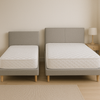Top 7 Mistakes to Avoid When Buying a New Bed (And What to Do Instead)
- by Mariam Labadze
Quick Answer
Common bed-buying mistakes undermine sleep quality and waste money: purchasing mattresses without adequate testing (spend 15-20 minutes lying in actual sleeping positions), ignoring partner compatibility (test together, consider motion isolation needs), choosing incorrect firmness based on assumptions rather than body weight and sleeping position, neglecting bed frame and base quality that dramatically affects mattress performance and longevity, buying purely on price without considering cost-per-year value, failing to measure access routes causing delivery nightmares, and skipping warranty and return policy reviews creating problems if issues arise. Instead: test thoroughly in showrooms, research firmness requirements matching your weight (under 70kg needs softer, over 90kg requires firmer), invest in quality bases preventing premature mattress failure, calculate total ownership costs, measure doorways and staircases before ordering, and understand protection terms before purchasing.
[toc]
Mistake 1: Inadequate Testing Before Purchase
The Problem – Many buyers spend mere minutes testing beds in showrooms, performing quick "bounce tests" while sitting on edges or lying briefly on backs. This superficial evaluation fails revealing actual sleeping comfort during extended periods in various positions that real sleep involves.
The pressure to decide quickly in retail environments, combined with self-consciousness about spending extended time testing in public spaces, causes rushed decisions that costly regret follows when mattresses arrive home and prove uncomfortable during actual nightly use.
Online mattress purchases without any physical testing compound this problem. While generous trial periods supposedly mitigate risk, the hassle of returns and disruption to sleep during trial periods creates strong psychological bias toward keeping mediocre mattresses rather than enduring return processes.
The Solution – Spend minimum 15-20 minutes testing each serious contender, cycling through your actual sleeping positions. Start on your back, then shift to your preferred side, and finally test any other positions you regularly use during nights. This comprehensive testing reveals comfort across realistic sleeping scenarios rather than single-position impressions.
Remove shoes and lie properly rather than perching awkwardly in street clothes. While you needn't bring pajamas, at least lying flat in relaxed positions provides far better assessment than sitting on edges or lying stiffly in business attire feeling self-conscious.
Visit showrooms during quieter periods when possible—weekday mornings or early afternoons typically prove less busy than weekends, allowing extended testing without feeling rushed by crowds or sales pressure that busy periods create.
For online purchases, thoroughly research return policies and trial period terms before ordering. Understand exactly what happens if mattresses prove unsuitable—who arranges collection, any restocking fees, refund timing, and whether you're responsible for return shipping costs that sometimes prove substantial.
Mistake 2: Ignoring Partner Compatibility
The Problem – Couples often test beds individually or make decisions without both partners participating, leading to situations where one person loves the mattress while the other sleeps poorly every night. Comfort preferences vary tremendously—different body weights, sleeping positions, and temperature sensitivities mean one mattress rarely satisfies both partners equally without compromise.
Motion transfer proves particularly problematic for couples with different sleep schedules or one partner moving frequently during nights. Traditional sprung mattresses transmit movement across surfaces, disturbing lighter sleepers whenever partners shift positions, creating cumulative sleep disruption affecting both partners' rest quality.
The Solution – Test mattresses together whenever possible, lying side-by-side in your typical sleeping arrangements. Have one partner move while the other remains still, assessing how much motion transfers across mattress surfaces. Quality pocket sprung and memory foam mattresses minimize transfer, while traditional open coil springs transmit movement significantly.
Consider split mattresses or dual-firmness options if preferences differ substantially. Some manufacturers offer mattresses with different firmness levels on each side, or you can purchase two singles zipping together creating king or super king sizes while accommodating individual preferences without compromising either partner's comfort.
Discuss honestly about temperature preferences. Memory foam retains heat while pocket springs and hybrids provide better cooling. If one partner sleeps hot while the other feels cold, look for mattresses with temperature-regulating technologies or cooling gel layers helping manage these competing requirements.
For couples with significantly different body weights (more than 30kg difference), medium-firm mattresses often work better than very soft or very firm extremes. The moderate firmness accommodates both lighter and heavier partners reasonably, though neither may achieve their absolute ideal comfort.
Mistake 3: Choosing Wrong Firmness Levels
The Problem – Many buyers select firmness based on vague preferences or marketing descriptions rather than understanding how body weight and sleeping position determine appropriate support levels. "Medium-firm suits everyone" represents oversimplification—what feels perfect for 60kg side sleepers proves rock-hard for similar-weight back sleepers or too soft for 95kg individuals regardless of sleeping position.
The confusion increases with inconsistent industry terminology where "medium" from one manufacturer feels like another's "firm" and a third's "medium-soft." Without standardized firmness scales, buyers struggle comparing options across brands, often making decisions based on misleading or incomparable descriptions.
The Solution – Start with body weight and primary sleeping position determining appropriate firmness ranges:
Lightweight (under 70kg): Medium to medium-soft mattresses typically work best. Heavier firmness prevents adequate contouring causing pressure points at shoulders and hips particularly for side sleepers. Back sleepers in this weight range tolerate slightly firmer than side sleepers but still benefit from modest softness allowing natural spine curvature.
Medium weight (70-90kg): Medium to medium-firm provides appropriate support for most sleeping positions. This weight range tolerates the widest firmness spectrum, though side sleepers still prefer medium while back and stomach sleepers lean toward medium-firm.
Heavy weight (over 90kg): Firm to extra-firm prevents excessive sinking that causes spinal misalignment and difficulty moving during nights. Heavier bodies need substantial support that softer mattresses cannot provide without uncomfortable sinking and premature mattress deterioration from concentrated pressure.
Sleeping position refinement:
-
Side sleepers need softer surfaces allowing shoulder and hip pressure relief
-
Back sleepers require moderate support maintaining lumbar curve without gaps
-
Stomach sleepers need firmer surfaces preventing hip sinking that strains lower backs
Test firmness by lying in actual sleeping positions for extended periods. If shoulders or hips ache within minutes on sides, the mattress proves too firm. If you feel you're sinking excessively or struggling to shift positions, it's too soft.
Mistake 4: Neglecting Base and Frame Quality
The Problem – Buyers invest in quality mattresses while pairing them with inadequate bases or frames, dramatically undermining mattress performance and longevity. Mattress manufacturers design products expecting proper support foundations—specifications often explicitly require appropriate bases for warranties remaining valid.
Placing new mattresses on old, sagging bases, inappropriate slatted frames with excessive spacing, or completely unsupportive surfaces causes premature mattress deterioration, voided warranties, and compromised comfort that buyers incorrectly attribute to mattress quality rather than recognizing foundation inadequacy.
Old divan bases with broken springs, slatted beds with gaps exceeding 7-8cm, or metal frames lacking center support all compromise even premium mattresses. The mattress bears weight without adequate underlying support, causing premature sagging, reduced comfort, and shortened lifespan regardless of mattress quality.
The Solution – Budget for complete bed systems rather than mattresses alone. Quality divan bases, appropriate slatted frames, or platform beds designed for modern mattress constructions all prove worthwhile investments protecting mattress investments whilst ensuring optimal comfort and longevity.
For slatted frames, verify slat spacing remains under 7-8cm—wider gaps allow mattresses sagging between slats creating uncomfortable ridges and premature wear. Some mattresses require solid platforms or closely-spaced slats for warranty validity, so check manufacturer specifications before purchasing frames separately from mattresses.
Replace old divan bases when purchasing new mattresses unless existing bases remain in excellent condition (under 5 years old with no sagging, broken springs, or structural damage). The £200-£400 base investment proves worthwhile through extended mattress lifespan and better sleep quality that proper support provides.
Consider the total system height combining base, mattress, and any toppers. Total sleeping surface heights ranging 50-65cm from floor suit most adults—lower proves difficult for elderly or mobility-limited individuals, while higher creates awkward entry/exit and potentially unstable feelings.
Mistake 5: Buying Purely on Price
The Problem – Budget constraints prove real, but extreme economy in mattress purchases proves false savings when cheap mattresses fail within 2-3 years requiring replacement. The £200 bargain mattress costing £67 annually through three-year lifespan actually proves more expensive than £600 quality mattresses lasting nine years at £67 annually—identical annual costs but vastly different sleep quality.
Sale pricing and promotional offers create urgency causing rushed decisions without adequate research or testing. "60% off today only" creates pressure that clouds judgment, causing buyers accepting mediocre products they'd reject under calmer decision-making conditions.
Cheap mattresses typically use low-density foams, thin comfort layers, and minimal springs creating initially acceptable comfort that deteriorates rapidly. Within months, body impressions develop, support diminishes, and regret sets in—but sunk cost fallacy and return hassles mean continuing suffering with poor purchases rather than cutting losses through replacement.
The Solution – Calculate cost-per-year rather than comparing purchase prices. Divide total cost by realistic lifespan (budget mattresses: 3-5 years, mid-range: 7-9 years, premium: 10-12 years) revealing actual value. This perspective often shows mid-range mattresses (£500-£800) offering best value through balancing upfront costs with adequate longevity.
Set realistic budgets acknowledging that quality mattresses represent significant investments but ones amortized across thousands of nights' sleep. A £700 mattress over eight years costs approximately £0.24 per night—trivial expense for something affecting health, energy, and daily functioning as profoundly as sleep quality does.
Research brands and construction quality rather than simply seeking lowest prices. Read reviews focusing on longevity comments—do mattresses maintain comfort after 2-3 years, or do reviewers mention rapid deterioration? Long-term satisfaction matters far more than initial impressions when purchases last nearly a decade.
Time purchases strategically around genuine sales events (January sales, Black Friday) rather than responding to constant "limited time offers" that actually represent everyday pricing with inflated reference prices creating false urgency.
Mistake 6: Failing to Measure Access Routes
The Problem – Buyers measure bedroom spaces ensuring beds fit rooms but forget measuring doorways, stairwells, hallways, and any tight corners between delivery vehicles and destination bedrooms. This oversight creates delivery nightmares when king or super king mattresses physically cannot navigate narrow Victorian stairwells or modern apartment building corridors.
The problem particularly affects rolled or vacuum-packed mattresses that arrive compressed but expand to full size upon opening. While compressed dimensions fit through tight access easily, some buyers mistakenly unpack in hallways or on staircases rather than destination rooms, discovering expanded mattresses cannot navigate remaining distance to bedrooms.
Traditional sprung mattresses maintain full dimensions during delivery, meaning every doorway, corner, and stairwell must accommodate full mattress widths and lengths simultaneously—often requiring diagonal angling that exceeds simple dimension checking without considering three-dimensional space navigation.
The Solution – Measure all access points before ordering:
-
External doors: Most UK external doors measure 75-80cm width, adequate for singles and small doubles but challenging for kings and super kings
-
Internal doorways: Typically 75cm, measure actual clearances as decorative frames or thick paint sometimes reduce effective widths
-
Stairwell widths: Measure at narrowest points including any mid-landing turns where mattress length might exceed available turning radius
-
Hallway widths: Particularly in apartments, narrow hallways sometimes prove impossible for large mattress navigation regardless of door clearances
Calculate diagonal measurements for traditional sprung mattresses—these often represent critical dimensions exceeding simple width or length measurements. For a 150x200cm king, the diagonal measures approximately 250cm, requiring clearances accommodating this dimension during angled navigation through doorways.
For vacuum-packed options, verify you have assistance available immediately upon delivery for moving to destination rooms before unpacking. Once opened, these mattresses expand within minutes, becoming impossible maneuvering through tight spaces that compressed versions easily navigated.
Contact retailers about access concerns before ordering. Professional delivery teams have extensive experience navigating difficult access and can advise on feasibility, alternative delivery methods, or whether specific mattress types (rolled versus traditional) prove more suitable for your access challenges.
Mistake 7: Skipping Warranty and Return Policy Review
The Problem – Buyers fail reading warranty terms and return policies carefully, discovering too late that coverage excludes the specific problems they're experiencing, requires burdensome documentation manufacturers use discouraging legitimate claims, or contains restrictions making protection essentially worthless despite impressive-sounding length.
"10-year warranty" sounds reassuring until reading fine print revealing coverage limited to specific defects excluding the comfort deterioration or sagging most mattresses experience, or requiring professional measurements confirming indentations exceeding arbitrary thresholds that actual problems never quite reach despite obvious deterioration.
Trial period terms prove equally problematic. Some require keeping mattresses minimum periods (30-60 days) before allowing returns—supposedly allowing bodies adjusting to new sleeping surfaces, but actually creating psychological barriers to returns through sunk cost fallacy after enduring uncomfortable sleep for months.
The Solution – Read complete warranty terms before purchasing, not after problems arise. Specifically verify:
What's actually covered: Body impressions, spring failures, cover defects? Are comfort preferences excluded? Is deterioration covered or only manufacturing defects?
Coverage conditions: Does warranty require specific bases, protectors, or foundations? Do violations void warranties completely? Must you register products within specific timeframes?
Claim processes: What documentation proves defects? Must you pay inspection fees? Who determines whether problems warrant coverage? Are claims handled by manufacturers or retailers?
Pro-rated vs. non-pro-rated: Non-pro-rated provides full value replacement throughout warranty periods while pro-rated reduces coverage value over time, potentially leaving you paying substantial portions of replacement costs despite "warranty coverage."
For trial periods, understand:
-
Exact length and any minimum keeping requirements
-
Return shipping responsibility and costs
-
Refund timing and any restocking fees
-
Condition requirements for returns (original packaging, hygiene covers, etc.)
Choose retailers and brands known for honoring warranties and handling returns fairly rather than those creating bureaucratic obstacles discouraging legitimate claims. Research customer service reputations through independent reviews rather than trusting marketing claims about "hassle-free" returns that actual customers describe very differently.
At Moorcroft Beds, we're committed to helping customers avoiding these common mistakes through honest guidance, generous testing time, transparent policies, and quality products backed by meaningful warranties. Our experienced team has seen these errors countless times and can help steering you toward decisions you'll still appreciate years later when quality choices continue delivering comfortable, restorative sleep night after night.




